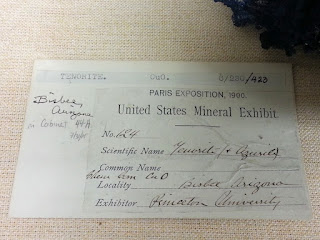Barb wire bird with full moon.
A digital archive of strange and beautiful things from my travels in the Arizona desert.
Sunday, December 6, 2015
Sunday, September 27, 2015
Mine Stench Gas
Mine stench gas is a warning system used to alert workers underground of an emergency situation. It works by releasing ethyl mercaptan into the air supply, the same "rotten egg smell" chemical that is added to natural gas to aid in leak detection.
Esoterizona Stones 36
Fluorescent Minerals
Calcite (bright red), dolomite (dark red), and willemite (green). The combination of calcite and dolomite is known as "crazy calcite." 5"x3"x2.5" Franklin, NJ.
Same as above, white light.
Calcite (red), gemmy willemite (green), and black non-fluorescent franklinite. 4"x4"x2.5" Franklin, NJ.
Above specimen, white light. The light-colored vein is willemite and non-fluorescent pink rhodonite.
A large face of hardystonite (blue) and clinohedrite (orange) with traces of willemite and calcite. 5.5"x4"x2.5" Franklin, NJ.
Same as above, white light. Minor black franklinite is also visible.
Monday, September 14, 2015
Trailer Trash
This trailer has been abandoned in the mountains.
Inside are boxes of drill-core samples, like this one. Before commencing operations, mining companies retrieve and catalog these samples to assess the viability of their claim.
The trailer is full of these boxes, definitely beckoning further exploration, but the trailer is also what a health professional would refer to as a "hantavirus nightmare." Rodent droppings cover all horizontal surfaces, and nests are hidden among the stacks. Not to mention the possibility of catching plague from the fleas. Next time take a hazmat suit.
Modern Mining
A close-up look at a modern mining operation ..
This a major avenue into the mountain.
It is large enough to accommodate heavy equipment traffic, and a significant portion of the terrain surrounding the mine has been transformed into an artificial, reinforced facade.
The mine is also well blocked against intrusion by locked gates and barriers. Cool air streams steadily from the opening, most likely powered by the second portal located higher up the mountain, and chilled by the damp chambers between the two openings.
Sunday, September 13, 2015
Sunday, August 30, 2015
Esoterizona Stones 35
Fluorescent Minerals
Calcite (red) and fluorite (purple) from the Pure Potential Mine. 6"x3.5"x2" (La Paz County)

White light - you can see the white bands of fluorite cutting through the brown calcite.

With longwave UV, only the fluorite is visible.
Fluorapatite (violet) and hyalite opal (green) from the Cerro de Mercado Mine, Durango, Mexico. Midwave UV activates the fluorapatite, while the hyalite opal responds to shortwave UV. 4"x3"x2.5"
Fluorapatite, midwave UV only.
Also a very aesthetic white light specimen
Calcite (red), fluorite (purple), and willemite (green) from the "3-Color-Mine" near Silverbell, AZ. 3"x2.5"x1"
White light.
All three specimens purchased from Polman Minerals.
Saturday, August 29, 2015
Paul Don's Food Center
The demolition of Guilin Restaurant on Speedway Blvd in Tucson revealed this old painted advertisement for Paul Don's Food Center, Home of Pampered Poultry.
Printed advertisements for Paul Don's appear in the Tucson Daily Citizen during the years 1948-1958, first as an independent grocery, and later (around 1951) as a member of Associated Grocers (AG), a group that formed in 1948 as a means for independent grocers to join together and compete with larger regional chains.
For more information, see: A Historical Look at Arizona's Food Industry
The former breezeway between the two buildings, where the sign was hidden from view.
The wall has since been painted to match the rest of the building.
According to a quick search, the term "Pampered Poultry" is now used by people who dress up and accessorize their pet chickens. I doubt that is what Paul Don meant.
Thursday, August 13, 2015
Rillito Flow
Pictured below is the normally dry and dusty Rillito River crossing on Camino de la Tierra, near I-10 in Tucson. Photos taken the morning after torrential monsoon storms swept across the Santa Catalina mountains. Here, over fifteen miles from the headwaters, the muddy river is easily two hundred feet across and still flows swiftly.
Thursday, August 6, 2015
Cactus Bloom, with Bees
Pictured below is the flower of the night-blooming Peruvian apple cactus (Cereus peruvianus), also featured in Bloom Time 3 on this website.
In that post I stated that the flower is pollinated by the nocturnal white-lined sphinx moth, which is true. But, on this cloudy morning, the dancing honeybees also play their role.
Sunday, August 2, 2015
Canyon Metates
Hand-bored metates (or pestles), roughly one thousand years old, in a large bedrock boulder. Presumably they were used by native inhabitants to grind foodstuffs such as mesquite beans or corn into usable meal. This boulder was part of large jumble situated on a canyon rim overlooking a choke point and natural waterfall.
Most contained some water, but only this one was streaked with vivid plant life.
Saturday, August 1, 2015
U of A Mineral Museum 4
The University of Arizona Mineral Museum features many amazing specimens from all over the world. Tourmaline (aka elbaite) is one of my favorites.
U of A Mineral Museum 1
The following photos are from the U of A Mineral Museum, on campus at 1601 E University Blvd. These are specimens from historically significant Arizona localities that are now and forever closed to collecting, such as Bisbee, Glove, and Tiger-St Anthony.
Friday, July 31, 2015
Subscribe to:
Posts (Atom)


















































